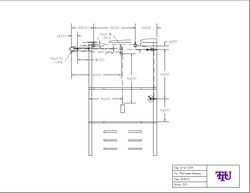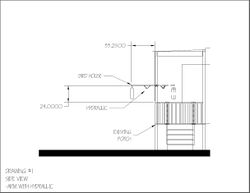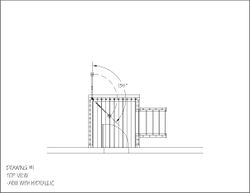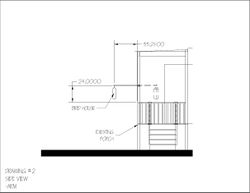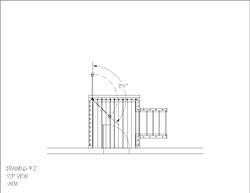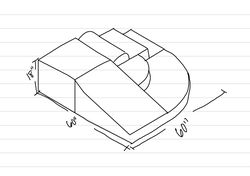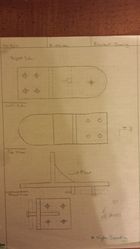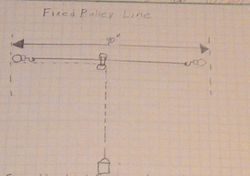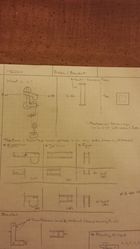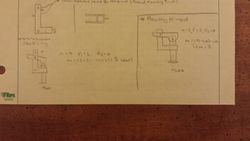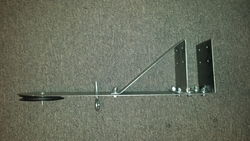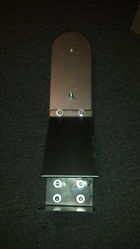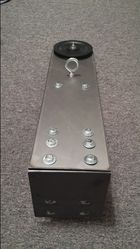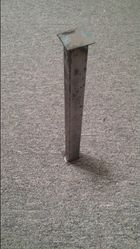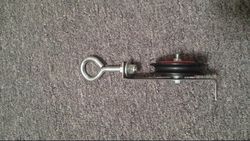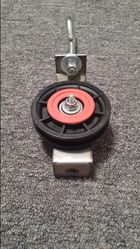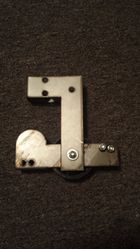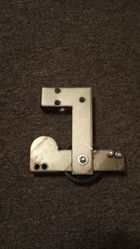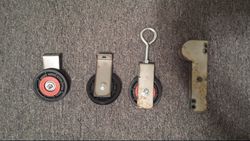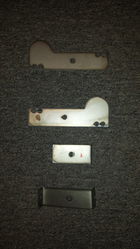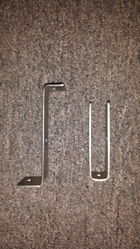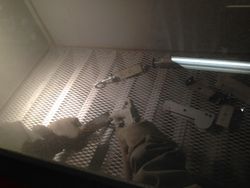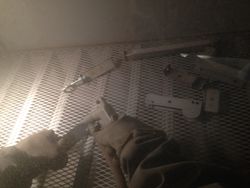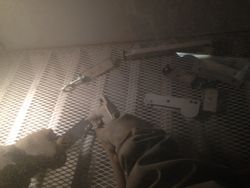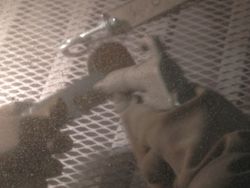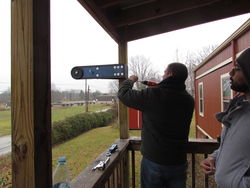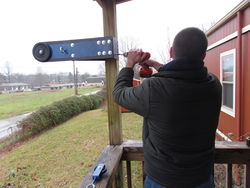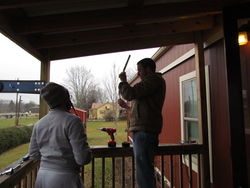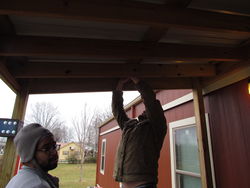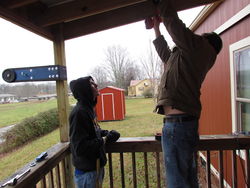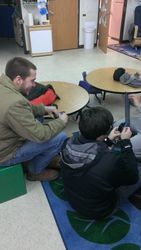Adjustable birdfeeder F13
Abstract
Design a movable bird feeder system that will allow the feeder to be brought in and filled from the back porch and sent back out afterward.
Team members
- Mohanad Almokhodm
- Andrew Gardner
- Michael Palmer
- Eli Ramsey
- Kyle Spalding
- Kyle Wilson
Problem Statement/Overview of Need
The children at a developmental preschool enjoy filling a bird feeder located on the back porch. When the birds come to the feeder, they make a mess which is difficult to clean up. It is desired to have a system which will allow the bird feeder to be brought in when the children want to fill it, but be able to be sent back out after so that the birds will not make a mess.
Design Specifications
1. 1.5 feet minimum distance from porch when extended
2. Rest 10 inches from the floor of the porch when filling
3. Must not interfere with the back door which protrudes 33 inches from the back of the house
4. Must be durable to endure animals, normal wear and tear, and the elements
5. Must be easy to operate and handle
Conceptual Design
Design Concept 1: Pulley System
Using a series of pulleys and hooks, the system will all be self-contained in one area of the existing porch. It will be operated by a crank mechanism that will allow it to be sent out and brought in. In addition, using gravity, the bird feeder will be able to be lowered to a suitable height so that it can be filled by the children
Pros:
- Feeder can hang away from porch to limit mess
- Easy to bring in and send out for refilling
- Cost-effective and simple assembly
- Easy-to-use
Cons:
- Due to nature of components used, periodic maintenance and replacement is necessary
Design Concept 2: Swivel Base, Hydraulic Arm
The bird feeder would be attached to an arm that has a hydraulic member and a swivel at the base. This would allow the feeder to be brought in and out easily, and the feeder would have an adjustable length so that the user can choose how far or close the feeder is. This adjustable feature would also allow for the feeder to assume a smaller size when near the porch for refilling.
Pros:
- Ease of use
- Aesthetically pleasing
Cons:
- Parts will eventually fail resulting in repair cost
Design Concept 3: Swivel Base, Fixed Arm
This approach is quite similar to the hydraulic arm. However, instead of an adjustable arm, the arm length is fixed.
Pros:
- System will work for extensive period of time
- Requires little to no maintenance after it is installed
Cons:
- Requires more force to operate
- Potentially less aesthetically pleasing
Evaluate concepts/select candidate
It is the belief of the design team that using the pulley system would be the best design to fulfill the objectives listed above. It will allow the bird feeder to be brought in and out, and lowered to the level of the children. Also, by using a crank of some kind (captain's wheel, single handle, etc.) we will allow the children to have a role in the operation. This should help strengthen the upper body strength of children that need that type of therapy and allow the children to have a little fun and feel involved.
Detailed Design
Description of selected design
The design team has opted to use a system of multiple pulleys and cable that will allow the bird feeder to transport from point A to B with ease.
Detailed description of selected design
The system utilizes one input located waist level on the existing porch, two separate cables and six pulleys of two selected diameters. One cable serves to direct the feeder from one location to the other -- having constant length and a slight angle to aid in translation. While, the other cable will have changing length determined by the input which serves as a control. The cable selected is commonly used in exercise equipment and is nylon coated for added safety. A bracket is to be fabricated from stainless steel sheet metal and will be bolted to an existing pole located on the porch -- this component will be the connecting point for the second cable and house one pulley. The purpose of the bracket is to extend a surface from the existing porch such that the feeder hangs a selected distance away. We have determined that a combination of a ratcheting mechanism paired with a large diameter wheel would be ideal for controlling the motion of the system.
Analysis
Engineering analysis 1 - Functionality
| Point | Ratcheting Crank | Gear Mechanism (Foot Pedal) | Captain's Wheel (Bolted to Spool) |
|---|---|---|---|
| 1. Safety | Capable of locking into position | Low effort required - moving parts are shielded | Free to move - potential for injury |
| 2. Availability | Adapted from marine application (boat lift) | Utilizes Jamitorcal tool found at Walmart for wringing out mops | Endless options - considering automotive or marine style |
| 3. Functionality | Capable of controlling motion in each direction | Operates unidirectional - complicated system | Larger diameter wheels reduce force required (operates both directions) |
Conclusion
For safety and ease of use we will be combining a ratchet mechanism with a large diameter wheel. The ratchet mechanism provides safety by locking in each position during use. The use of a steering wheel makes the task entertaining while also reducing the effort required to operate.
The general design is as follows:
Engineering analysis 2 - Physics
For the bird feeder to return to ground, the fixed pulley line will need enough slant to allow gravity pull the feeder horizontally when the crank is reversed. To achieve this horizontal movement, we have decided that a 0.6° slope between the fixed pulleys will allow this motion to commence. Using the equation tan(0.6)*90 (inches), we find the pulleys need to be vertically separated approximately 1 inch.
In the event that the bird feeder reaches its final position before achieving maximum height a kinetic brake has been devised:
Engineering analysis 3 - Mobility
The bird feeder system has an overall mobility of two independent movements. The system will be able to move in both vertical and horizontal directions. Since the feeder and support system are in a single plane, there is no mobility in the z-direction. Because most of the system consists of fixed pulleys and rope, which will not change in length or angle, it will be considered rigid. There will be 3 links (ground, combined pulleys, and the rope). One F1 joint (slider on the top pulley) is to be considered, as well as two F2 joints (point contacts between two pulleys, and point contacts between rope and pulley).
Consideration of the kinetic brake yields:
CAD Drawings
Bill of Materials
| Quantity | Item | Source | Cost (USD) |
|---|---|---|---|
| 1 | 6" Diameter Pulley | MSC Direct | 18.86 |
| 6 | 3" Diameter Pulley | MSC Direct | 85.98 |
| 1 | 36" x 24" Steel Sheet Metal | Lowe's | 26.16 |
| 20 | Socket Head Screws | Lowe's | 26.20 |
| 20 | Washers | Lowe's | 5.20 |
| 5 | Cable Crimps (Package of two) | Lowe's | 8.50 |
| 1 | Nylon Coated Cable | Sportsmith | 78.00 |
| 1 | Electric Winch w/ Control | eTrailer | 399.95 |
Total Units: ~55
Total Cost: ~$648.85
Fabrication Process
Assembly
On Saturday, December 7, 2013, the team traveled to the development preschool facility to install the device. When we got there, we found that it would be better to set up the system on the front porch. While installing everything, we found that our original placement of the components needed to be modified slightly. To accomplish this, we raised the main arm attachment to a higher position on the porch frame. This aided in the birdfeeder being able to return to a position the would be easily accessible when brought in. To further enable the feeder to be brought in, it was decided that some other item, such as a spring, would be attached to have an opposing force acting when in the extended position.
Completed design
Instructions for safe use
Device should not be operated unless under the supervision of an adult.
Keep all foreign objects, including appendages, away from the electric winch due to moving parts.
Summary and Conclusions
The team was tasked with the design and implementation of a system that would allow a birdfeeder to be transported away from the deck to keep the mess made by the birds to a minimum. The bird feeder was also required to be able to be brought back in easily so that it can be accessed. The team designed a pulley system to be used with an electric winch that would accomplish this task. This design was analyzed thoroughly to ensure that the system would be safe and used with ease by the children at the development preschool.
While this project presented many challenges, the design team worked efficiently together to rise above them. It is the belief of the team that all objectives were met, and the system that was provided will effectively transport the birdfeeder to help keep the area clean.
